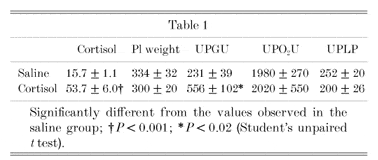During pregnancy, consumption of nutrients by the uteroplacental (UP) tissues reduces nutrient availability to the fetus. Towards term, there are decreases in the fetal growth rate and umbilical glucose uptake, which closely parallel the normal prepartum increase in fetal plasma cortisol (Fowden et al. 1996, 1998). Raising cortisol levels earlier in gestation has also been shown to prematurely reduce the rates of fetal growth and umbilical glucose uptake (Fowden et al. 1996; Ward et al. 2001), yet little is known about the effects of cortisol on UP metabolism. This study examined the effects of fetal cortisol on the consumption and production of nutrients by the ovine UP tissues during late gestation.
All animal procedures were conducted in accordance with the UK Animals (Scientific Procedures) Act 1986. Under general anaesthesia (1-2 % halothane in O2/N2O2), intravascular catheters were inserted into 16 Welsh Mountain ewes and their fetuses between 115 and 118 days of gestation (term 145 ± 2 days). At least 6 days after surgery, the fetuses were infused I.V. with either cortisol (n = 8, 1-2 mg kg-1 day-1 Efcortisol, Glaxo Ltd), or saline (n = 8, 0.9 % w/v NaCl, 2.4 ml day-1). On the fifth day of infusion, UP uptake and/or production of glucose, lactate and oxygen were measured by the Fick principle, as the difference or sum of the uterine and umbilical uptakes or outputs using antipyrine to measure umbilical and uterine blood flows (Fowden et al. 1998). Plasma cortisol concentrations were measured by RIA, and blood levels of antipyrine, glucose, lactate and oxygen were measured as described previously (Fowden et al. 1998). Mean values (± S.E.M.) of fetal plasma cortisol (ng ml-1), placental (Pl) weight (g), rates (µmol min-1 kg-1 placental weight) of UP glucose utilization (UPGU), oxygen utilization (UPO2U) and of lactate production (UPLP) for the two treatments are shown in Table 1.
Cortisol infusion raised fetal cortisol levels to prepartum values and significantly increased UPGU, but not UPO2U or UPLP. This cortisol induced increase in UPGU may explain, in part, the decreased umbilical supply of glucose to the fetus seen in these circumstances (Ward et al. 2001). The observations show that UP metabolism is responsive to changes in the fetal cortisol level and suggest that cortisol may alter the relative contributions of different substrates to oxidative metabolism in utero.
This work was supported by the Avrith Research Studentship, Department of Physiology, University of Cambridge.

